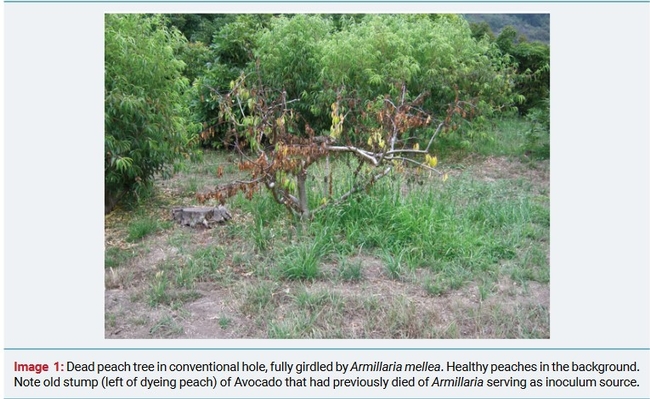Armillaria mellea is the pathogen that causes root rot of many forest and ornamental and agronomic trees. The pathogen occurs in landscapes and urban soils as well as a natural pathogen in forests and on lands converted to farming. While symptoms can appear suddenly, it is generally considered a slowly developing pathogen that takes years to kill a tree. When infected trees begin to die and are removed from orchards the fungus rapidly colonizes the remaining roots and resides in soil as potential inoculum for trees planted later.
Armillaria is difficult to control. Fungicides are not effective and even the most effective fumigants such as methyl bromide may not completely eradicate Armillaria from soils. Sterol demethylation inhibiting fungicides can be effective in slowing and preventing Armillaria infections in grape and stone fruit crops. Fungicides if used frequently are subject to breakdown in effectiveness through pathogen resistance to the treatment.
Adding uncomposted organic matter to soil provides the carbon and energy necessary to build microbial populations in soil, some of which are antagonistic to Armillaria. Mulches of bark and fresh woody debris of Scots pine increased soil microbial activity and organisms (fungi) eleven years after treatment. In this study both Trichoderma koingii and fresh wood and bark mulches applied to soil increased T. verde. Tree wood products such as yardwste or tree trimmings wastes are effective substrate for culture of many different fungi including Trichoderma spp. Downer et al, found that Armillaria mellea only survived a maximum of 11 days in fresh yardwaste static piles and that recovery of viable Armillaria was negatively associated with increases in Trichoderma in the wood chips.
Trichoderma have long been understood to play a role in control of Armillaria, especially after soil fumigation. Some effectiveness has been shown with Trichoderma in concert with other non-chemical methods.
In this study two potential cultural controls (hole size and yardwaste amending) and one biological treatment (Trichoderma application) on their ability to help peach trees survive Armillaria infested soil.
Peaches, Prunus persica were planted as grafted saplings in an avocado orchard previously infested with Armillaria mellea (Vahl) P.Kumm. Peaches were used because they are so sensitive to the fungus. Trees were planted in large or small holes withor without fresh yardwaste chips added as an amendment and with or without a Trichodermabiocontrol product sprayed into the hole. Trees were monitored for six years -- growth and mortality was tabulated. Six years later 40% of the trees had died from the disease. Trees planted in a large hole were more likely to survive than in a smaller hole (P=0.07) and trees in large holes with fresh organic matter added were the most likely to survive (P=0.04). Trichoderma sprays in the planting hole did not increase survival rates. While growth was initially retarded by adding fresh yardwaste to the hole, in later years none of the treatments affected growth rates
Read on: https://www.plantsciencejournal.com/apdf/jpsp-aid1031.pdf
